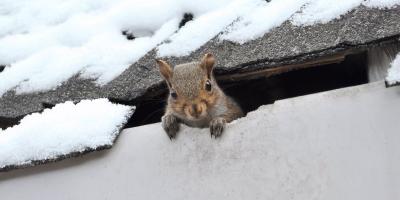The Perfect Storm: Snow, Mice & Ticks

As we move into the winter season, it’s important to understand that ticks are prevalent year-round. Although we tend to focus on them more during the warmer summer and early fall months, the fact is, ticks are a year-round threat. Understanding the seasonality of ticks and their symbiotic relationship with other species is important in order to avoid encountering them now and in subsequent seasons.
A Tick for All Seasons
Typically, the chance of coming home with a tick is higher after spending time in tall grasses, leaf piles or near overgrown shrubs during the spring and summer, and even fall. Those of us who spend more time outdoors increase our risk of exposure to tick bites, especially during their primary feeding seasons: spring, summer and fall.
It’s important to note that while certain conditions prove more favorable for ticks, they do remain active until the temperature falls below freezing. Avoid thinking “out of sight, out of mind,” when it comes to ticks; just because you can’t see them doesn’t mean they aren’t there. In fact, ticks have adapted to survive all four New England seasons.
This is because, after hatching from their eggs in the spring, ticks feed during each of the following three stages of their life cycle: six-legged larva (spring and summer); eight-legged nymph (spring and summer); finally, adult (fall). They need blood during each stage in order to advance to the next and complete their life cycle.
So, what do they do in the winter?
While there is undeniably higher tick activity during the warmer months, ticks have adapted to survive the winter months as well. Despite the cold, ticks do not die in the winter as many people assume. Unlike other animals, they do not migrate or hibernate either.
Ticks survive New England winters in a few ways, depending on their species and life cycle stage. Some ticks, like blacklegged “deer” ticks, might go dormant, which simply means that they are temporarily inactive. This is not to be confused with hibernation, which is a specific type of dormancy that some warm-blooded animals do on the same seasonal basis.
While some ticks go dormant, others, like the aptly named “winter tick,” can continue their lives as normal throughout the colder months. This is because, unlike blacklegged and dog ticks, winter ticks live their lives attached to a single host rather than dropping off after each meal. This makes not only feeding time much easier, but the winter as well since their animal host will continue generating plenty of heat. Meanwhile, the ticks that typically give us humans trouble will shelter in leaf litter found on the ground of forests and woodlands (the same places where you would expect to encounter ticks when the ground isn’t covered in snow).
The falling snow, especially as it accumulates on top of leaf debris, provides insulation for ticks, keeping them safe beneath from frigid temperatures. Certain species of ticks called “soft-shell” ticks will even stay put in burrows or dens underground until the temperatures are more favorable for them to emerge and resume activity.
Seasonal Protection, Year-Round
Despite being present during the winter months, ticks are not as much of a concern because they do not feed when the temperatures drop below forty-five degrees. The trouble is that New England winters do not always stay below freezing, and ticks are just as eager to take advantage of the Indian summer days as we are. This is why it is important to take precautions against ticks, even during these unseasonably warm periods.
Protecting yourself from ticks during the wintertime involves the same measures as the active spring and summer months. If you’re going to venture into wooded areas, wearing long pants tucked into your socks is a smart move, along with using a tick repellant. As soon as you return indoors, spend some time checking yourself thoroughly for ticks. Be sure to do the same for your pets, which are especially susceptible to tick bites.
Meanwhile, although we can enjoy temporary comfort from the fact that tick activity will soon drop with the temperatures, there are measures we can take now to minimize our tick exposure in the upcoming warmer months. Those measures start with isolating another pest that promotes tick populations: the common house mouse.

Winter Woes: A Mouse in the House
Many New England homeowners have dealt with mouse issues in the winter, as they are notorious for their uncanny skill of breaking and entering without the use of a door. While most of us can relate to the undebatable fact that they are indoor pests, they are just as much outdoor pests due to their arcane relationship with ticks.
There is a direct correlation between rodent populations and tick populations, based on the fact that rodents are almost always a nymph tick’s first meal come springtime. Without easy access to their first victim, far fewer ticks make it to adulthood, and on to larger prey like humans and pets.
So what can we do about it now?
It’s no secret that the rodent populations have been incredibly high in 2020, and there’s little doubt that these populations will only further inflate as the temperature drops… which equals a high tick population predicted in 2021.
The trick: Do your part to help reduce mouse populations now, by not letting them run rampant through your home and away from the outside elements. Of course, mice aren’t good to have in your house either, which is why mouse control, in and of itself, is important for the health of your home and family.
Mitigate Mice and Tamp Down on Ticks
Did you know that there is a direct correlation between mouse and tick populations? It’s true: As rodents become more populous, so do ticks soon afterwards. This is for the simple fact that rodents, usually mice, are often a tick nymph’s first meal before they learn to hunt larger prey. This is why it is even more important to control mouse populations in and around your home, if you want to minimize your chances of tick exposure in the near future.
The first line of defense against mice (and ticks, by association) involves taking preventive measures around the exterior of your home. Keep in mind that even the smallest opportunity (an opening only as thick as a pencil) will invite mice to wiggle their way in, which is easy given their collapsible skeleton and lack of collarbone. If they find it too tough of a squeeze, they will simply gnaw themselves a larger access space, which can result in costly damage.
It’s important to recognize that these small openings can appear at any time of year. Given that wood expands and contracts with temperature and humidity levels, as part of a structure’s natural settling process, always take into account the age of your home. Generally, the older the house gets, the more common these openings will become. In other words, just because you didn’t have mice last year or the year before doesn’t mean they won’t show up this year. Stay vigilant and aware of your home’s structural integrity.
Once inside, mice pose a risk of both electrical and insulation damage, not to mention the health of the people and pets inside. An estimated 20-25% of house fires with unknown causes are attributed to rodents chewing on electrical wires, and of course the more rodents on site, the higher the risk.
Setting bait stations to feed the mice -- for good -- will deter them from approaching the interior of your home for food and harborage. Homeowners should also spend some time before the first snowfall to walk the outside perimeter and look for any cracks or crevices that could give a mouse access to the indoors. These can include gutters, drains and holes for utility lines.
Look carefully and think like a mouse, because lower rodent populations in and around your home now will mean fewer ticks in the months to come.
To learn more about how to reduce rodent and tick populations in and around your home, contact us for a free quote, and receive $50 off a new service.
*New services only. Restrictions and limitations may apply. Contact a customer support specialist for details. Offer valid through 12/31/20.



